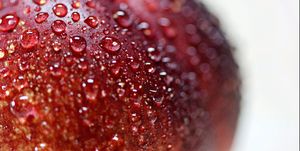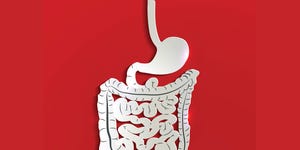
Listen, you don’t have to admit that you do it, but looking at the toilet paper after you poop every once in a while is pretty damn essential to your health.
Most of the time, you’re going to see what should be a welcome sight: smears in a medium-brown shade. But seeing something that looks bloody? Super-scary.
There are plenty of reasons why you might be seeing blood after you wipe. (FYI: Not all of them are scary!) But yeah, no matter the cause, you should definitely still consult your doc.
1. You have hemorrhoids.
Hemorrhoids are blood vessels in the anal canal that have become irritated or swollen, says Rashimi Kumar, M.D., a gastroenterologist at Banner – University Medicine Digestive Institute, and are brought on by an increase in rectal pressure (like constipation, straining while pooping, or even pregnancy).
They’re very common (about half of all people have had hemorrhoids by age 50, per the U.S. National Library of Medicine), and can either be external (around the anal opening) or internal (inside the anal canal). They’re also (luckily) painless, but can cause itching, skin irritation, and obviously, bleeding.

You can use a sitz bath ( just a warm, shallow bath for your butt) or hydrocortisone suppositories for quick relief, says Kumar, but the real issue is changing your hemorrhoid-causing habits to begin with. If constipation is the root cause of your hemorrhoids, for instance, try drinking eight to 10 classes of water and eating at least 25 to 30 grams of fiber a day. Also, skip the smartphone or reading on the toilet, Kumar says. “The longer you spend straining to evacuate you bowels, you could be making hemorrhoids worse.” Think: Get in, do the deuce, get out.
2. You have inflammatory bowel disease (IBD).
So, IBD is actually an umbrella term for two conditions that involve chronic inflammation of the gastrointestinal (GI) tract: Crohn’s disease and ulcerative colitis (UC). “UC affects the colon and the rectum,” Kumar says, “while Crohn’s is very patchy and can affect any part of the GI tract from mouth to anus.”
Ulcerative colitis is more likely to present with bleeding as it starts in the rectum, she says. Other symptoms include abdominal pain and persistent diarrhea, fatigue, and weight loss.

Something to note: “IBD is different from IBS, irritable bowel syndrome,” Kumar says. “With IBS, there’s no blood in the stool. The usual symptoms are abdominal pain, bloating, and constipation.” IBS is also more common in women and patients with anxiety and depression.
There are many different types of meds that deal with the inflammation, like prednisone, to treat IBD, but severe cases might require surgery to remove the damaged sections of the GI tract.
3. You have diverticular bleeding.
Diverticula are a pouch-like structures that can develop in the colon and eventually bleed, says Kumar (when you have these pouches, you have a condition called diverticulosis). It’s not entirely known why these diverticula form, but it’s thought that it has something to do with weak spots in the colon wall.
There isn’t typically any abdominal or rectal pain associated with the condition, but the bleeding can be so severe that you might end up in the hospital for a colonoscopy to identify the site of the bleeding. After a diagnosis, your doctor might prescribe a high-fiber diet to help stop diverticula from forming, says Kumar.
4. You have an anal fissure.
Anal fissures are essentially small, but painful tears in the thin lining in the anal canal. Fissures are caused by local trauma and high anal pressure, like during vaginal childbirth, passing very hard stools, or anal sex, Kumar says.
Also: When you have an anal fissure, you’ll know—it’s that painful, and the pain only gets worse when you’re trying to poop.

Your best bet to is to go see your doctor for this one (all of them, TBH). You’ll likely be prescribed the same remedies that help with hemorrhoids, like sitz baths and adding more fiber to your diet, says Kumar, but for anal fissures, a topical analgesic is often prescribed to help with pain. Anal fissures usually take four to six weeks to fully heal.
5. Your skin is just irritated, TBH.
The skin in the anal area is still skin and therefore subject to irritation caused by things like wiping too much or too vigorously (thanks, diarrhea) or from moisture left behind because of leaking or even staying in your sweaty gym leggings.
In minor cases (like if you see tiny spots of blood on the TP), you’ll just want to pay special attention to your rear-end skin; but if you’re seeing a bit more blood, your doctor might prescribe a cream to help keep the skin in that area dry, says Kumar.
6. You have colorectal cancer.
Colorectal cancer (a.k.a., cancer of the colon and/or rectal area) is actually the second most common cancer in women, globally, says Kumar. But there’s good news: It’s preventable by screening with a colonoscopy. “I cannot emphasize enough how important it is to get screening by colonoscopy at the age of 50, and 45 for African Americans,” says Kumar.

Colorectal tumors actually tend to bleed, which is why patients can notice blood in their stool, says Kumar. Aside from bleeding, another warning sign to watch for is a change in pooping patterns. If you’re usually pretty regular, but are now dealing with persistent constipation (or diarrhea), definitely get evaluated, Kumar says. Other symptoms include abdominal pain, weight loss, and fatigue.
As far as treatment goes, it really depends on the size and location of the tumor, the stage of the cancer, and whether it has spread. Doctors may recommend chemotherapy, radiation therapy, or surgery to remove the cancer.
Source: Read Full Article
